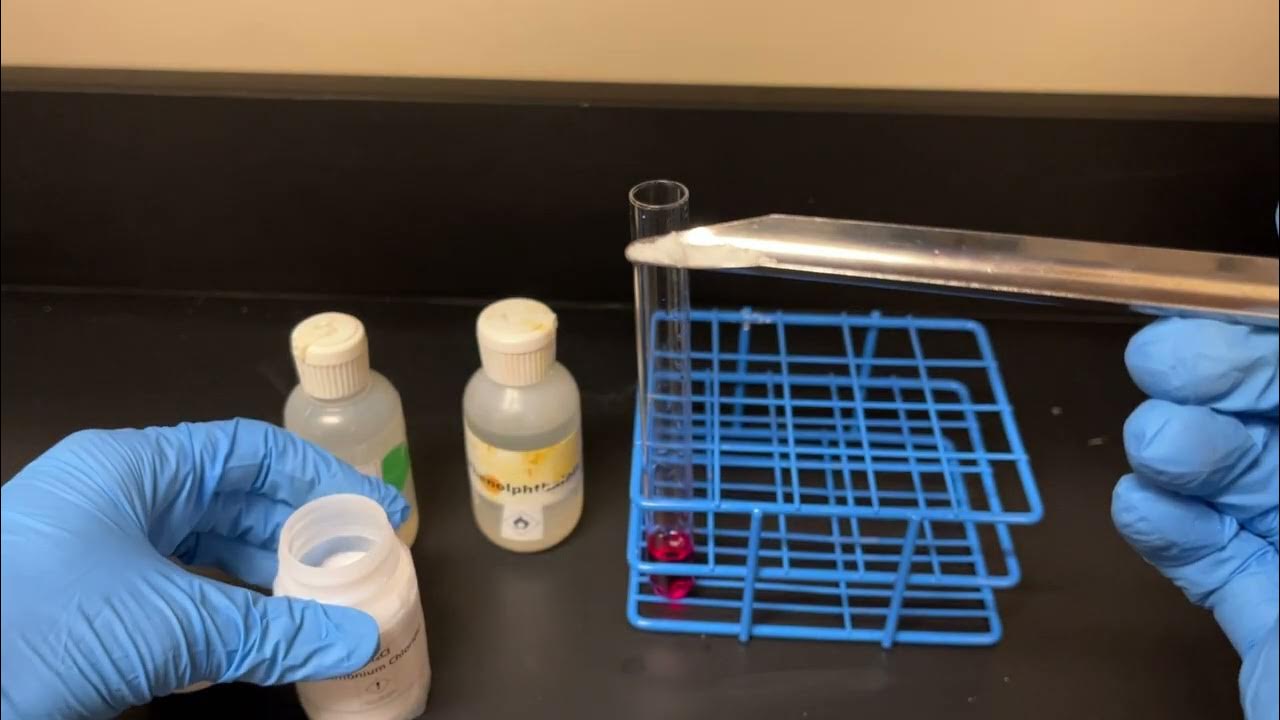Ketone Bodies in Determination in Urine | Qualitative Urine Analysis | Urine Ketone Bodies | ENGLISH
Summary
TLDRThis video demonstrates a chemical experiment to detect ketone bodies in urine, using ammonium sulfate, sodium nitrite, and strong ammonium solution. The process involves adding ammonium sulfate to saturate the urine sample, followed by sodium nitrite and ammonium solution to observe a color change. A 'perm magnate' color indicates the presence of ketone bodies, commonly found in individuals with diabetes or kidney dysfunction. The test mimics real-life conditions, with acetone added to simulate ketone production. The color change confirms impaired kidney function and abnormal fat breakdown, important for diagnosing metabolic issues like diabetic ketoacidosis.
Takeaways
- 😀 The experiment aims to detect ketone bodies in urine using specific chemical reactions.
- 😀 A 5 ml urine sample is transferred into a test tube as the base for the experiment.
- 😀 Ammonium sulfate is gradually added to the test tube until a saturated solution is achieved.
- 😀 Dissolution of ammonium sulfate is monitored by shaking the test tube and looking for residue.
- 😀 Once no more ammonium sulfate dissolves, the solution reaches saturation, indicated by visible residue.
- 😀 Two drops of sodium nitrite are added to the solution to begin the next stage of the reaction.
- 😀 2 ml of strong ammonium sulfate solution is added after sodium nitrite to further test for ketone bodies.
- 😀 If no color change occurs, it indicates an absence of ketone bodies in the sample.
- 😀 To simulate ketone bodies, acetone is added to a normal urine sample to mimic the presence of ketones.
- 😀 In a positive result, a purple color (permanganate) develops, indicating the presence of ketone bodies.
- 😀 The presence of ketone bodies suggests abnormal kidney function, commonly seen in diabetes, where the body breaks down fat to produce glucose.
Q & A
What is the purpose of this experiment?
-The purpose of this experiment is to detect the presence of ketone bodies in a urine sample, which can indicate abnormal kidney function or conditions like diabetes.
How much urine sample is used for the test?
-A 5 ml sample of normal urine is used for the experiment.
What is the role of ammonium sulfate in this experiment?
-Ammonium sulfate is added to the urine sample to form a saturated solution. It helps precipitate certain compounds, which are crucial for detecting ketone bodies.
How do you know when the ammonium sulfate is fully dissolved in the urine sample?
-You know that the ammonium sulfate is fully dissolved when no more solid dissolves in the solution, and a residue of ammonium sulfate remains at the bottom of the test tube.
What does the addition of sodium nitrite do in the procedure?
-The addition of sodium nitrite helps in the reaction that can lead to the formation of a characteristic permagnet color if ketone bodies are present.
Why is strong ammonium solution added to the test tube?
-Strong ammonium solution is added to further facilitate the reaction and to help in detecting the permagnet color, which indicates the presence of ketone bodies in the sample.
What is the significance of the permagnet color change in this experiment?
-The appearance of a permagnet color indicates the presence of ketone bodies in the urine sample, which suggests possible conditions like diabetes or impaired kidney function.
What do you do if no color change occurs in the normal urine sample?
-If no color change occurs, it indicates the absence of ketone bodies. However, to simulate the presence of ketone bodies, acetone can be added to the urine sample to induce a positive result.
How does the presence of ketone bodies relate to kidney function?
-The presence of ketone bodies suggests that the body is breaking down fat for energy due to an inability to use insulin effectively, often seen in conditions like diabetes. This can indicate abnormal kidney function as ketones are excreted in the urine.
Why is this test particularly useful for diagnosing diabetic conditions?
-This test is useful for diagnosing diabetic conditions because when insulin cannot be properly utilized, the body starts breaking down fat to produce glucose, leading to the production of ketone bodies, which are detectable in the urine.
Outlines

This section is available to paid users only. Please upgrade to access this part.
Upgrade NowMindmap

This section is available to paid users only. Please upgrade to access this part.
Upgrade NowKeywords

This section is available to paid users only. Please upgrade to access this part.
Upgrade NowHighlights

This section is available to paid users only. Please upgrade to access this part.
Upgrade NowTranscripts

This section is available to paid users only. Please upgrade to access this part.
Upgrade Now5.0 / 5 (0 votes)





